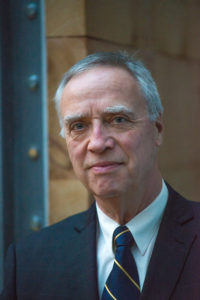
The following is a sponsored Q&A with the founders of the firm behind Canada’s new Prosperium cyryptocurrency.
Tony Humble is President and Chief Organizational Officer of Toronto-based Prosperium Inc. and Doug Coyle is Chief Executive Officer (both pictured on the left).
You can find the introductory blog in this series by clicking on Blockchain Revolution, Global Prosperity and Prosperium.
Also, a new white paper has just been published. The overall Prosperous business model is described on its home page. And for a layperson’s perspective, see Tony’s blog.
The Q&A will continue tomorrow.
Jon Chevreau: In the first blog, we mentioned Ethereum and Prospereum as two examples of cryptocurrencies spawned in Canada. Clearly, the name Ethereum inspired your name and it was a clever stroke to get the word Prosper in there too. Can you confirm this genesis of the name?

Tony Humble: Well, the name Prosperium was a natural, but we tried a few others first, like Prosperus, as in “prosper us all” and “prosperous” and ProsperX. But the elemental affinity with Ethereum was irresistible: like atomic bonds. Ethereum is named for both a celestial region and an “element” in the periodic table. On earth, it is both a currency and a platform for smart blockchain contracts: revolutionary and brilliant.
Jon: Can you elaborate on what the name means in practice, relative to Ethereum? Is it the same business model?
Tony: Like Bitcoin, the total number of coins issued by Etherium will be fixed, aiming for continuous growth in value. In comparison, Prosperium is also named as an element, is a crypto-currency, and is a platform: for growth in real prosperity. In contrast, however, once Prosperium has reached a target value it will be fixed in price and supported at that value, but the number of coins issued will continue to grow. It will be minted for measurable value, created by regional accelerators to generate jobs and production, and its use for transactional purposes will be tracked on the Prosperium blockchain. It will be 100% open and auditable by governments, and will maintain a large reserve to support the price in the marketplace.
Jon: A prospectus for Canada’s first Bitcoin ETF was recently filed. I’m not sure if that shows your timing is impeccable or whether you’re late to the party?
Doug Coyle: I do see that there are more and more ETF funds being launched in Canada and around the world for Bitcoin.
Jon: Starting with the Winklevoss twins of Facebook fame?
 Doug: Yes, they tried to get a Bitcoin ETF going and ran into some barriers but they prepared the ground a great deal. I feel it’s adding infrastructure so I’m in favor of multiple ETFs for Bitcoin or any other crypto currency being established.
Doug: Yes, they tried to get a Bitcoin ETF going and ran into some barriers but they prepared the ground a great deal. I feel it’s adding infrastructure so I’m in favor of multiple ETFs for Bitcoin or any other crypto currency being established.
Jon: Is Prosperium going that route?
Doug: Not directly. In some ways we do provide the ability for clients who hold Prosperium tokens to trade those tokens and eventually the currency itself will be freely trading; so we have a very sophisticated way of doing a — call it an ETF — but we hold a reserve account that is core to how we stabilize the Prosperium coin. Buyers can find a ready market there at all times; they don’t have to count on any broker to find a match on buying and selling; it’s all done automatically in the software.
Why Prosperium isn’t going the ICO route
Jon: You chose not to go the ICO (Initial Coin Offering) route although it sounds like you were thinking about it. Why not, or are you doing the same thing under a different name?
Doug: That’s right, and for a few reasons. One is regulatory and the other is the unique nature of Prosperium. On the regulatory side, the guidelines that have come out particularly from the Ontario Securities Commission (OSC) and in the US from regulators have all indicated in most cases they will treat these ICOs as securities that should have been properly structured. By not following the established rules for launching a new security, a lot of tokens are opening themselves up to at the very least cease-and-desist orders and possibly more serious consequences if they’ve been engaged in anything that disadvantages the public in any way.
 The unique nature of Prosperium is the other reason; we are heading towards a stable-value currency: a currency that doesn’t go up and up and up or isn’t volatile the way Bitcoin and most cryptocurrencies are. Bitcoin is based on having a fixed amount of currency out there; so as demand for it increases, the price will go up … They do produce some new currency at the present time but ultimately there is a final fixed number for all of the Bitcoins that are ever going to exist in the world. They’ve all been mined.
The unique nature of Prosperium is the other reason; we are heading towards a stable-value currency: a currency that doesn’t go up and up and up or isn’t volatile the way Bitcoin and most cryptocurrencies are. Bitcoin is based on having a fixed amount of currency out there; so as demand for it increases, the price will go up … They do produce some new currency at the present time but ultimately there is a final fixed number for all of the Bitcoins that are ever going to exist in the world. They’ve all been mined.
Jon: Wasn’t it a really finite number like 21 million coins?
Doug: Yes, it is 21 million in the original white paper published by the anonymous Satoshi Nakamoto. That means the marketplace is always depending on in a sense a speculative value; the value is what the market says it is and the market can change its mind and it can go up and down in very large amounts, as we’ve seen the last year when Bitcoin has tripled or quadrupled.
Jon: 21 million seems like a ridiculously low number but Bitcoin can be divided into a huge number of infinitesimally small pieces?

Doug: Right. A lot of decimal places, which the average consumer finds a bit amusing; the fact they’ll only ever be 21 million Bitcoins is why the Bitcoin price is already at $4,000; that was the way Bitcoin was designed; on the other hand, Prosperium was designed to be a mainstream currency for everyday use in the mass market; it’s a currency you can pay your mortgage with, or buy groceries or a tank of gas: it’s a mainstream currency; therefore, you want a stable value. Most people hold Bitcoin only as a speculative value; and even if they take it in trade, they will not hold it for a long period because of its volatility.
How the Pre-Sale works
Jon: What stage are you in for your fund-raising? I believe details of your Pre-Sale just went up on your website.
Doug: That’s based on a mixture of how fast we accomplish our initial milestones; we have a roadmap that is quite detailed about partnering, finishing certain features of our software and getting certain things established, like the Reserve Account. Each step we accomplish increases the perceived value of our token. Part of it is strictly a market effect; what does the market believe. We’ve chosen not to tie it to a particular time; it’s difficult to say what day it will reach $4 in value. We’re at $2 right now and it says on our website we give a percentage how far we are to our target at $2.
Those are the people being rewarded with the biggest potential gain as it goes up to $100: a 50-times gain. They are getting that big reward because they’re investing in a platform that is at its very beginning; there’s all sorts of risk about how the Regulators are going to treat us, are we going to accomplish our objectives in a competent way, all the normal risks you see when you invest in a new thing so it has a commensurate gain. As we accomplish those things and confidence increases then we will make a decision that we can now ask $4 for our coins. Once the momentum starts, just like with Bitcoin the last 12 months, it can go very quickly up and up.
Jon: How much have you raised in the first round?
Doug: We went through a friends-and-family round before we started the $2 round we’re now in. We don’t give specific dollar amounts of where we are; we give guidance so people have some idea of how close we are to closing off a round. We don’t want everyone out there hanging back to the day before we go to $4: we want them to invest based on the company’s merits right now and its potential for the future.
Jon: How does the average non-accredited investor get in on this?

Tony: They can’t until we file a prospectus. The initial pre-public or pre-sale phase is for accredited investors only. Once we reach the point where we’re ready to file a prospectus we don’t have to rely on those prospectus exemptions so can then offer to the general public. We don’t yet know when that will be. We will judge that as we go along but as long as we take investments from accredited investors initially we have the freedom to have a prospectus offering and take funds from the general public, in time.
Doug: Correct: the equivalent of an ICO for Prosperium is a possibility: that’s one thing that’s been discussed. The other alternative is to work with the regulators and have Prosperium regulated as a currency by the financial institution regulators as opposed to securities regulators. But ultimately Prosperium dollars is a currency, designed to work with Governments and with businesses in the private economy.
Jon: Is this across Canada?
Tony: We’re in all 10 provinces, using national instruments for prospectus exemptions; till we get launched.
Tomorrow: More on Prosperium’s pre-sale rollout, Fiat currencies versus cybercurrencies, what backs Prosperium, and working with Government and Business to create prosperity locally.


